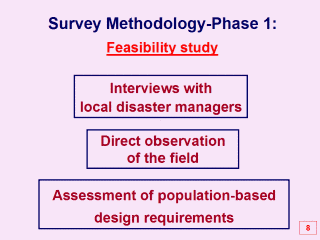| front |1 |2 |3 |4 |5 |6 |7 |8 |9 |10 |11 |12 |13 |14 |15 |16 |17 |18 |19 |20 |21 |22 |review |
 |
Before going to
Bam, I was blamed because some people believed that the people were so needy
and the situation was so catastrophic that conducting a study seemed a
little unethical. But soon after going there, I happened to know that the
major problem of the people was lack of evidence-based information of
decision-makers. I conducted 2 surveys there, on the needs of survivors and
rescue teams. Also, some other points were addressed, which you will see
later.
Herein I ’d like to discuss with you some methodological points, which I have learned and used and may be applied in the same situations.During the first day visit of Bam the following assessments were done. First, a feasibility study including: 1) Interviews with local disaster managers to assess their knowledge and attitude toward the necessity of research activities after an earthquake and to estimate their level of supports and possible limitations 2) To estimate the available facilities for data collection such as transportation and basic needs of interviewers consisting of tents, food, water and latrines. 3) Assessment of population-based design requirement, including living status of people by direct observation and asking for available information of geographical distribution of population and the map of city. Second, some interviews were done. 1) Ten in-depth interviews with people from different corners of the city to assess their needs, living status and their cooperation. 2) Three interviews with rescue teams about their needs and health problems. |